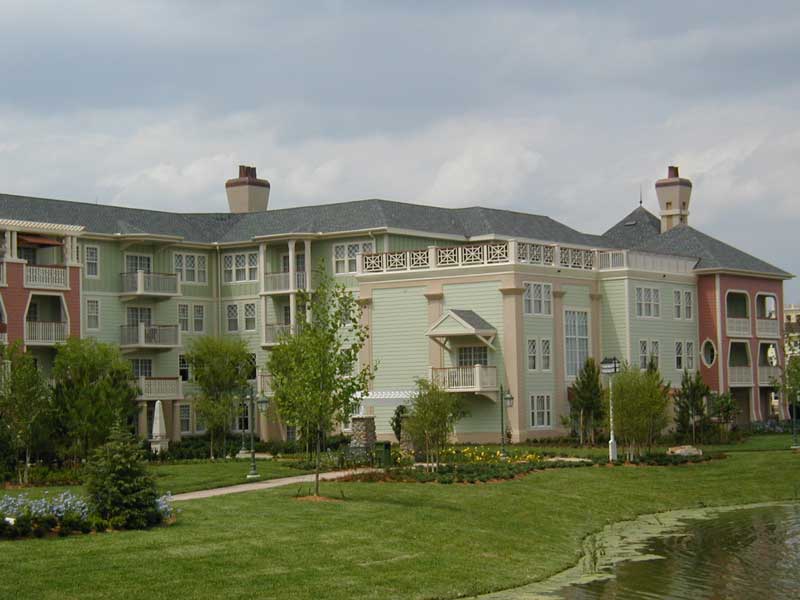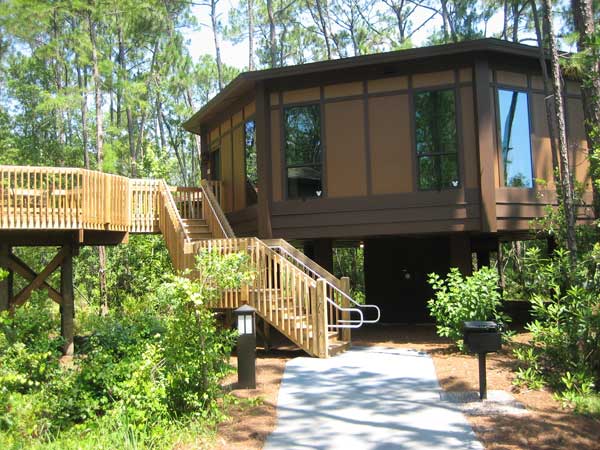In part one of the discussions regarding the Disney Vacation Club timeline, I focused on the genesis of the initiative as well as the original strategy Disney held for their new endeavor. Of particular note were the stronger ties to the early days of timeshares, the idea that DVC members might not care whether a participating resort was near a theme park. The other aspect that bleeds into today’s topic is the struggle Disney faced when they didn’t have an empowered relationship with local and state governments.
{multithumb thumb_width=600 thumb_height=400 thumb_proportions=bestfit}
Disney's Saratoga Springs Resort & Spa
As the calendar turned to the 21st century and a new millennium, the Disney Vacation Club approached its 10th anniversary. The first nine years of the faux-timeshare service had suffered through the tumult of growing pains, and the Disney Decade was now complete. Then-CEO Michael Eisner still had another five years ahead as the leader of The Walt Disney Company, but the company was about to flatline as a stock due to elements completely beyond his or anyone else’s control.
Almost 10 years after the first sales in the Disney Vacation Club (September 30, 1991), Americans suffered through the events of 9/11. The stock market crashed, and Disney tapered some of their more ambitious plans afterward to adjust to the new political climate. Eisner would later state in an interview that it was the first time Disney stock fell back during his tenure, but he ultimately never recovered from this setback. How much impact the tragic series of events had on DVC expansion plans is up for debate.
What’s clear from the situation is that Disney refocused on monetizing. Any entity of theirs with a precarious financial position shifted from a long-term endeavor to worthy of immediate replacement. And that’s how the Disney Institute’s main campus switched from a training and educational vacation program to the largest participant in The Disney Vacation Club in terms of available accommodations.
As originally conceived, the Disney Institute would mimic the Chautauqua Institute, an adult education center in New York. Eisner visited it with his family in 1985 and came back emboldened that his company could do something similar. The business world revered the Disney training program, and a recreational facility teaching the cast member way represented a new spin on vacationing. Families could enjoy the benefits of the Most Magical Place on Earth, Walt Disney World, while also taking classes in cooking, animation, and the like.
Alas, not many vacationers embraced the idea of combining Walt Disney World with training days. When the economy tanked in 2001, the numbers told the story for Eisner. He accepted his loss and repurposed the main campus into something that would spike the bottom line of his company. The Disney Vacation Club was an unqualified success already. The primary concern Disney had faced throughout the first decade was a lack of rooms. They believed they could sell more DVC memberships if they simply had more accommodations available.
In 1985, this tract of land had the name of Walt Disney World Village Resort. In 1989, it changed to Disney’s Village Resort. By 1995, Disney had altered the name once again, this time choosing the Villas at the Disney Institute. It wasn’t until 2004 that the property gained its current and presumably final name, Disney's Saratoga Springs Resort & Spa. Had the Disney Institute succeeded as planned, DVC members wouldn’t enjoy the seemingly always available 1,320 rooms at the resort closest to Disney Springs.
For whatever reason, the Disney Institute always seemed to be in trouble. Even after Saratoga Springs opened, the company intended to maintain the Treehouse Villas. These would linger as permanent housing for the International College Program Cast Members. Mother Nature had other plans.
Treehouse Villas at Disney's Saratoga Springs Resort & Spa
In 2004, Hurricane Charlie gusted through central Orlando, damaging several of the Treehouse Villas in the process. The facility no longer complied with federal and state codes for residential housing. This explains why Disney bulldozed them and then started from scratch with the current iteration of the Treehouse Villas at Disney’s Saratoga Springs Resort & Spa. History was against the Disney Institute as Michael Eisner envisioned it but fully supportive of the largest DVC facility.
While arguably the most important Disney Vacation Club addition of the early 21st century, Saratoga Springs wasn’t the first. In May of 2000, Disney park planners announced their intent to add a second resort across Crescent Lake from the already popular Disney’s BoardWalk Villas. The latter property’s mix of rooms at Disney's BoardWalk Inn & Villas succeeded far beyond expectations. The idea of a matching themed resort seemed organic. Nobody could have anticipated just how much guests would love it, though.
Disney's Beach Club Villas arrived in 2002 ans was an instant hit with owners. Part of the explanation for its high occupancy was its size - only 208 rooms, significantly lower than the 383 villas at the corresponding DVC property across Crescent Lake. It also had a strong theme of Newport Beach cottages, tying back to the project mentioned in part one. Once Disney recognized that they couldn’t control the government at Newport Beach, they mirrored the look and style at property where they had such power. It just so happened to be in Florida rather than California.
Disney's Beach Club Resort
Guests who have spent any time at Disney’s Beach Club Resort understand its appeal. The property is strikingly beautiful as well as waterfront. It also features an ace in the hole, Stormalong Bay. This three-acre pool area is effectively a small water park, and access to it is available only to guests of this hotel and the adjoining Disney’s Yacht Club Resort. Out of the nine Disney Vacation Club properties at Walt Disney World, Disney’s Beach Club Villas is consistently the hardest to book at seven months despite being one of the older options, which speaks volumes about its quality.
Stormalong Bay
In 2005, carriers of the torch of the Disney legacy such as Roy E. Disney finally got their way. Eisner was finally pushed out. His replacement, Bob Iger, enjoyed much more respect internally and externally by this point. He’d held the titles of company president and chief operating officer for more than five years, and the decade he’s spent as Disney CEO is unquestionably the company’s finest since Walt Disney was alive. One of his first missions was to redeem a failed Eisner initiative. You can read about the introduction of Disney’s fourth gate, Disney's Animal Kingdom, here if so inclined. If not, the gist is that that park and Disney's Hollywood Studios have always struggled in comparison to Epcot and Magic Kingdom.
Iger appreciated that the beauty of the site itself was something he could accentuate. He planned to construct neighboring resorts that mirrored the breathtaking scenery of Animal Kingdom. In addition, they too would celebrate man’s interactions with nature by including mini-zoos onsite. The idea of a theme park combined with a zoo already stood apart as unprecedented. Carrying that idea over to a pair of resorts demonstrated the sort of bravado that would become a staple of Iger’s tenure as Disney CEO.
The other important footnote about this project involved Disney’s financials. Besides the repurposing of the Disney Institute, a facility that had suffered an identity crisis for a couple of decades, the Disney Vacation Club hadn’t done much for a while. The Villas at Disney’s Wilderness Lodge debuted in 2000 and Disney’s Beach Club Villas were announced prior to 9/11. Other than monetizing the lands of Disney Institute, DVC had sat in neutral for several years as Disney suffered through financial struggles and in-fighting.
Everything changed with the introduction of Disney’s Animal Kingdom Villas. The twin resorts would become the fifth properties at Walt Disney World as well as the eighth overall. Most importantly, they were the first two positioned close to Disney's Animal Kingdom. Iger’s staff deduced that they could impact the perception of the half-day park, at least some, if they built nightly accommodations nearby.
Lobby overlook at Jambo House
How much the gamble worked is up for debate. What isn’t in doubt is that Jambo House and Kidani Village are both breathtaking facilities. The lobbies of these resorts celebrate African heritage and culture in awe-inspiring fashion. A simple walk outside brings guests in close proximity to the other inhabitants of these residences. A stay at Disney’s Animal Kingdom Villas is a rare opportunity to watch animals from faraway lands, and they, unlike vacationers, never leave the area.
Kidani Village
Iger deserves acclamation for his daring in not just adding a new DVC construction after years of upheaval but also crafting one of the most original hotels in the world. A visit to Disney’s Animal Kingdom Villas is like a trip to the zoo, only it’s unclear who is watching who. Animals see so many humans on a daily basis at these resorts that we’re no longer a curiosity to them. Its 2007 debut still stands as one of the greatest achievements in the history of the Disney Vacation Club.
This brings us to the end of part two, which covers the early 21st century. This series will conclude in part three. In the final chapter, we’ll start with an awkward business negotiation whose ramifications are yet to be understood fully. Then, we’ll discuss the long-anticipated expansion to a different theme park. Finally, we’ll examine the impact of the monorail resorts on DVC.
(Hat tip to DVCInfo.com for resources used in this story.)
Disney Vacation Club member David Mumpower first visited Walt Disney World when he was six years old. The little brat promptly threw a tantrum because he couldn't find a comfortable shirt to wear around the park. Fortunately Disney shirts got a lot less itchy over the years. David current writes for a number of websites including "Theme Park Tourist", "Box Office Prophets" and "How Well Do You Know." To contact him click HERE.










